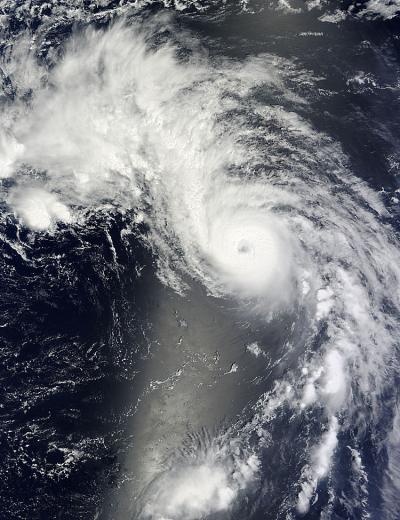Genevieve downgraded to a tropical storm

NASA's Terra satellite captured this image of Typhoon Genevieve on Aug. 9, 2014, at 23:15 UTC. Credit: Image Credit: NASA Goddard MODIS Rapid Response Team
The storm is located approximately 819 nautical miles west-northwest of Midway Island.
It is currently tracking northwestward at 8 knots per hour over the past six hours.
Maximum significant wave height is 32 feet.
Maximum sustained winds 70 knots gusting to 85 knots, with winds of 34 knots or higher occur within 80 to 105 miles of the cente,r and winds of 64 knots or higher occur within 15 miles of the center.
No landmasses are currently threatened by this storm.
Genevieve is moving northwest and has continued to weaken.
Unfavorable environmental factors has caused a rapid weakening over the past 12 hours.
The storm will dissipate within 2-3 days, far southeast of the Aleutian islands.
Text credit: Lynn Jenner
NASA's Goddard Space Flight Center
Media Contact
All latest news from the category: Earth Sciences
Earth Sciences (also referred to as Geosciences), which deals with basic issues surrounding our planet, plays a vital role in the area of energy and raw materials supply.
Earth Sciences comprises subjects such as geology, geography, geological informatics, paleontology, mineralogy, petrography, crystallography, geophysics, geodesy, glaciology, cartography, photogrammetry, meteorology and seismology, early-warning systems, earthquake research and polar research.
Newest articles

Making diamonds at ambient pressure
Scientists develop novel liquid metal alloy system to synthesize diamond under moderate conditions. Did you know that 99% of synthetic diamonds are currently produced using high-pressure and high-temperature (HPHT) methods?[2]…

Eruption of mega-magnetic star lights up nearby galaxy
Thanks to ESA satellites, an international team including UNIGE researchers has detected a giant eruption coming from a magnetar, an extremely magnetic neutron star. While ESA’s satellite INTEGRAL was observing…

Solving the riddle of the sphingolipids in coronary artery disease
Weill Cornell Medicine investigators have uncovered a way to unleash in blood vessels the protective effects of a type of fat-related molecule known as a sphingolipid, suggesting a promising new…





















